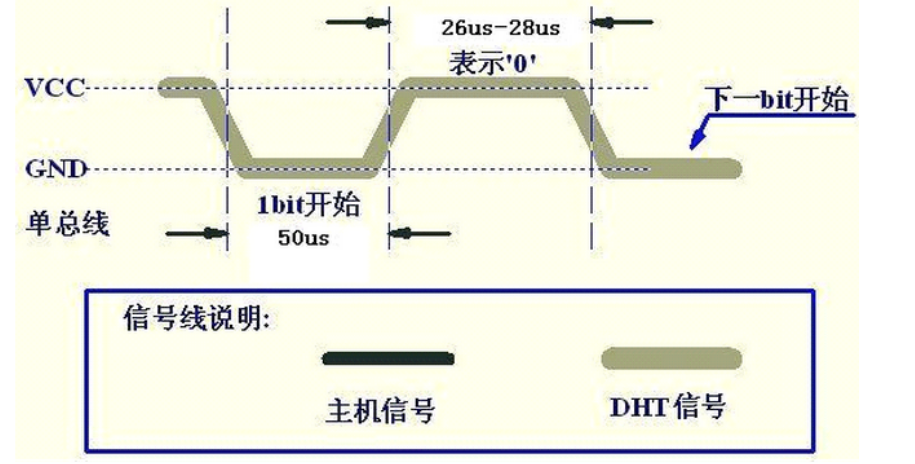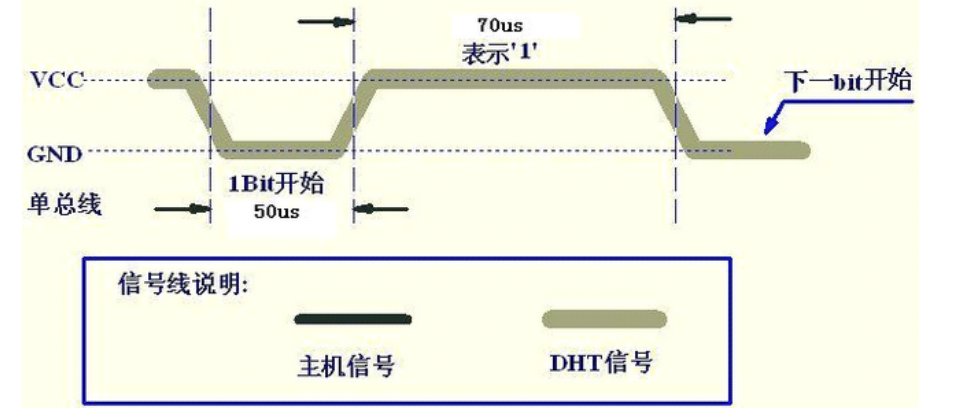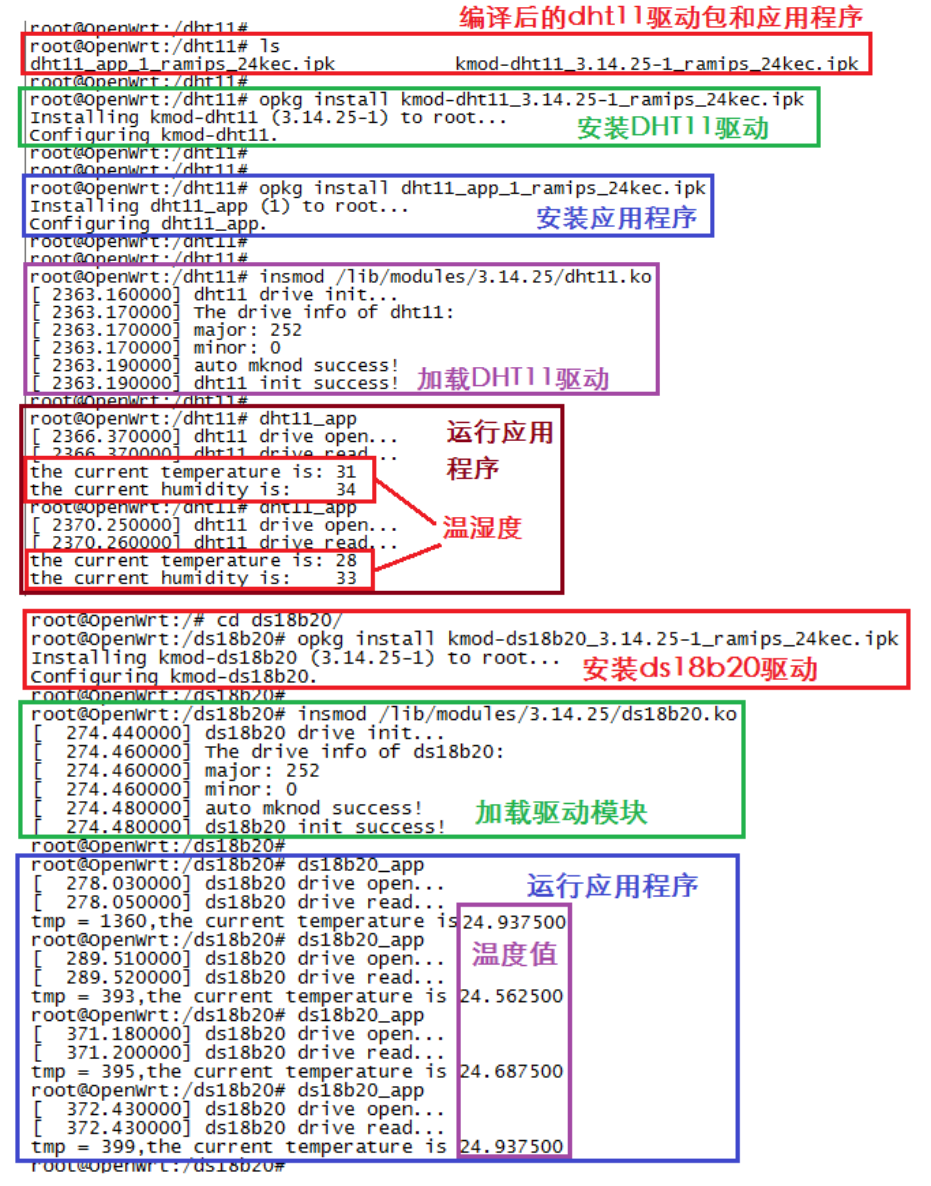

 Openwrt开发指南 第28章 DHT11 温湿度传感器
Openwrt开发指南 第28章 DHT11 温湿度传感器
描述
开发环境:
主机:Ubuntu12.04
开发板:RT5350
Openwrt:Openwrt15.05
1 硬件原理
下图是我们温度传感器的接入引脚,3.3V 供电,io 口接 P13 的 GP0( GPIO0 的简称 )。DHT11数字温湿度传感器 是一款含有已校准数字信号输出的温湿度复合传感器,它应用专用的数字模块采集技术和温湿度传感技术,确保产品具有极高的可靠性和卓越的长期稳定性。传感器包括一个电阻式感湿元件和一个NTC测温元件,并与一个高性能 8 位单片机相连接。因此该产品具有品质卓越、超快响应、抗干扰能力强、性价比极高等优点。每个DHT11 传感器都在极为精确的湿度校验室中进行校准。校准系数以程序的形式存在OTP内存中,传感器内部在检测型号的处理过程中要调用这些校准系数。单线制串行接口,使系统集成变得简易快捷。超小的体积、极低的功耗,使其成为该类应用中,在苛刻应用场合的最佳选择。
2 DHT11 相关时序
- 初始化(复位)时序图

- 控制器首先至少拉低 18ms,然后拉高 20-40us 后等待 DHT11 的应答
- 当 DHT11 检测到信号后,首先将总线拉低约 80us 然后在拉高 80us 作为应答信号。
- 读取数据时序图

- 表示 0 的时序如下

- 表示 1 的时序如下

- DHT11 以低电平应答主机,然后拉高总线准备输出。输出 0 信号和 1 信号都是以低电平开始高电平结束。
- DHT11 输出 0、 1 信号的低电平时间相同,而高电平的时间不同,输出 0 信号时高电平约 26-28us,而当输出 1 信号时高电平约为 70us。
3 驱动程序
关于字符设备驱动程序的使用,我们可以参照点亮 led 灯的那个实验,这里只给出跟DHT11 密切相关的驱动程序,详细的程序请查看我们的驱动文件!
//配置连接温度传感器的引脚
#define DHT11_L *GPIO21_0_DATA &= ~(1< < 0) //低电平
#define DHT11_H *GPIO21_0_DATA |= (1< < 0) //高电平
#define DHT11_OUT *GPIO21_0_DIR |= (1< < 0) //输出
#define DHT11_IN *GPIO21_0_DIR &= ~(1< < 0) //输入
#define DHT11_STA *GPIO21_0_DATA & 0x01
//寄存器定义
volatile unsigned long *GPIO21_0_DIR;
volatile unsigned long *GPIO21_0_DATA;
/**************** 基本定义 **********************/
//初始化函数必要资源定义
//用于初始化函数当中
//device number;
dev_t dev_num;
//struct dev
struct cdev dht11_cdev;
//auto "mknode /dev/dht11 c dev_num minor_num"
struct class *dht11_class = NULL;
struct device *dht11_device = NULL;
/******************** dht11有关的函数 ****************************/
//从dht11中读取一个字节
static unsigned char read_byte(void)
{
unsigned char r_val = 0;
unsigned char t_count = 0; //计时器,防止超时;
unsigned char i;
for(i = 0 ; i < 8 ; i++)
{
t_count = 0;
while(!DHT11_STA)
{
udelay(1);
t_count++;
if(t_count >250)
{
printk("read_byte error1n");
return 100;
}
}
t_count = 0;
udelay(32);
if(DHT11_STA == 1)
{
r_val < <= 1;
r_val |= 1;
}
else
{
r_val < <= 1;
continue;
}
while( DHT11_STA == 1 )
{
udelay(2);
t_count++;
if(t_count >250)
{
printk("read_byte error2n");
return 100;
}
}
}
return r_val;
}
//从dht11中读出数据
static unsigned int read_dht11(void)
{
unsigned char t_count = 0; //计时器;
unsigned int dht11 = 0;
unsigned char h_i = 0 , h_f = 0;
unsigned char t_i = 0 , t_f = 0;
unsigned char check_sum = 0;
DHT11_OUT;
DHT11_L;
mdelay(30); // >18ms;
DHT11_H;
udelay(30);
DHT11_IN;
while(DHT11_STA == 1)
{
udelay(1);
t_count++;
if(t_count > 50)
{
printk("device error: dht11!n");
return 0;
}
}
t_count = 0;
while(!DHT11_STA)
{
udelay(1);
t_count++;
if(t_count > 250)
{
printk("read_dht11 error1n");
return 0;
}
}
t_count = 0;
udelay(50);
while(DHT11_STA)
{
udelay(1);
t_count++;
if(t_count > 250)
{
printk("read_dht11 error2n");
return 0;
}
}
h_i = read_byte();
h_f = read_byte();
t_i = read_byte();
t_f = read_byte();
check_sum = read_byte();
if(check_sum == (h_i+h_f+t_i+t_f) || (h_i!=100 && t_i != 100))
{
dht11 = t_i;
dht11 < <= 8;
dht11 += h_i;
}
else
{
dht11 = 0;
printk("read_dht11 error3n");
}
return dht11;
}
/**********************************************************************/
/**************** 结构体 file_operations 成员函数 *****************/
//open
static int dht11_open(struct inode *inode, struct file *file)
{
printk("dht11 drive open...n");
DHT11_OUT;
DHT11_H;
return 0;
}
//close
static int dht11_close(struct inode *inode , struct file *file)
{
return 0;
}
//read
static ssize_t dht11_read(struct file *file, char __user *buffer,
size_t len, loff_t *pos)
{
unsigned int dht11;
printk("dht11 drive read...n");
dht11 = read_dht11();
copy_to_user(buffer, &dht11, 4);
return 4;
}
/***************** 结构体: file_operations ************************/
//struct
static const struct file_operations dht11_fops = {
.owner = THIS_MODULE,
.open = dht11_open,
.release = dht11_close,
.read = dht11_read,
};
/************* functions: init , exit*******************/
//条件值变量,用于指示资源是否正常使用
unsigned char init_flag = 0;
unsigned char add_code_flag = 0;
//init
static __init int dht11_init(void)
{
int ret_v = 0;
printk("dht11 drive init...n");
//函数alloc_chrdev_region主要参数说明:
//参数2: 次设备号
//参数3: 创建多少个设备
if( ( ret_v = alloc_chrdev_region(&dev_num,0,1,"dht11") ) < 0 )
{
goto dev_reg_error;
}
init_flag = 1; //标示设备创建成功;
printk("The drive info of dht11:nmajor: %dnminor: %dn",
MAJOR(dev_num),MINOR(dev_num));
cdev_init(&dht11_cdev,&dht11_fops);
if( (ret_v = cdev_add(&dht11_cdev,dev_num,1)) != 0 )
{
goto cdev_add_error;
}
dht11_class = class_create(THIS_MODULE,"dht11");
if( IS_ERR(dht11_class) )
{
goto class_c_error;
}
dht11_device = device_create(dht11_class,NULL,dev_num,NULL,"dht11");
if( IS_ERR(dht11_device) )
{
goto device_c_error;
}
printk("auto mknod success!n");
//------------ 请在此添加您的初始化程序 --------------//
GPIO21_0_DATA = (volatile unsigned long *)ioremap(0x10000620, 4);
GPIO21_0_DIR = (volatile unsigned long *)ioremap(0x10000624, 4);
//如果需要做错误处理,请:goto dht11_error;
add_code_flag = 1;
//---------------------- END ---------------------------//
goto init_success;
dev_reg_error:
printk("alloc_chrdev_region failedn");
return ret_v;
cdev_add_error:
printk("cdev_add failedn");
unregister_chrdev_region(dev_num, 1);
init_flag = 0;
return ret_v;
class_c_error:
printk("class_create failedn");
cdev_del(&dht11_cdev);
unregister_chrdev_region(dev_num, 1);
init_flag = 0;
return PTR_ERR(dht11_class);
device_c_error:
printk("device_create failedn");
cdev_del(&dht11_cdev);
unregister_chrdev_region(dev_num, 1);
class_destroy(dht11_class);
init_flag = 0;
return PTR_ERR(dht11_device);
//------------------ 请在此添加您的错误处理内容 ----------------//
dht11_error:
add_code_flag = 0;
return -1;
//-------------------- END -------------------//
init_success:
printk("dht11 init success!n");
return 0;
}
//exit
static __exit void dht11_exit(void)
{
printk("dht11 drive exit...n");
if(add_code_flag == 1)
{
//---------- 请在这里释放您的程序占有的资源 ---------//
printk("free your resources...n");
iounmap(GPIO21_0_DATA);
iounmap(GPIO21_0_DIR);
printk("free finishn");
//---------------------- END -------------------//
}
if(init_flag == 1)
{
//释放初始化使用到的资源;
cdev_del(&dht11_cdev);
unregister_chrdev_region(dev_num, 1);
device_unregister(dht11_device);
class_destroy(dht11_class);
}
}
/**************** module operations**********************/
//module loading
module_init(dht11_init);
module_exit(dht11_exit);
//some infomation
MODULE_LICENSE("GPL v2");
MODULE_AUTHOR("from Jafy");
MODULE_DESCRIPTION("dht11 drive");
/********************* The End ***************************/
4 应用程序
int main(int argc, char **argv)
{
int fd;
unsigned int dht11 = 0;
unsigned int humi,temp;
//打开温度传感器驱动模块
fd = open("/dev/dht11", O_RDWR | O_NONBLOCK);
if (fd < 0)
{
printf("can't open /dev/dht11n");
return -1;
}
read(fd, &dht11, sizeof(dht11));
temp = dht11 > >8;
humi = dht11 &0x000000ff;
printf("the current temperature is: %dn",temp);
printf("the current humidity is: %dn",humi);
close(fd);
return 0;
}
5 实验结果

审核编辑:汤梓红
声明:本文内容及配图由入驻作者撰写或者入驻合作网站授权转载。文章观点仅代表作者本人,不代表电子发烧友网立场。文章及其配图仅供工程师学习之用,如有内容侵权或者其他违规问题,请联系本站处理。
举报投诉
-
使用ESP8266驱动DHT11温湿度传感器2023-05-19 9467
-
DHT11温湿度传感器简介2022-02-16 4864
-
如何使用STM32F4来读取DHT11数字温湿度传感器2022-02-09 1373
-
dht11温湿度传感器有什么特点?怎么使用?2022-01-10 3654
-
如何使用nodemcu开发板与DHT11温湿度传感器获取温湿度数值?2021-10-28 1495
-
使用DHT11温湿度传感器2021-08-10 1479
-
DHT11温湿度传感器介绍2021-07-21 3575
-
Arduino开发板使用DHT11温湿度传感器的方法 精选资料分享2021-07-13 1702
-
基于arduino的dht11温湿度传感器的使用2018-01-22 48981
-
数字温湿度传感器 DHT112017-12-02 2358
-
DHT11温湿度传感器的原理资料2017-06-05 5129
-
DHT11温湿度传感器2016-07-25 10578
-
DHT11数字温湿度传感器产品介绍2010-02-26 1531
全部0条评论

快来发表一下你的评论吧 !

